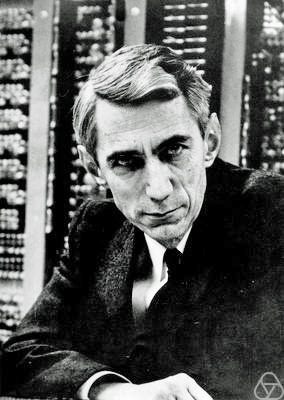This piece on Claude Shannon is the first in what will become a series of posts looking at the key figures who shaped the thoughts, theories, algorithms and technologies that we rely on in the world of vibration and acoustic measurement. Shannon is found in a number of posts on the Noise & Vibration Measurement Blog. Read more to discover why.
One of the fundamental forces behind our contemporary digital world is the work of a brilliant mathematician and engineer named Claude Shannon. His groundbreaking insights have driven the digital revolution, playing a critical role in the evolution of telecommunications, data compression, and the entire discipline of Information Theory. Despite the far-reaching implications of his work, he is often overshadowed by other computing pioneers like Alan Turing. This blog aims to shed some light on the life and achievements of this incredible man.

Born on April 30, 1916, in Petoskey, Michigan, Claude Elwood Shannon showed an early aptitude for mathematics and engineering. His love for science was fostered by his father, a judge and a businessman with a fascination for new technologies, and his mother, a high school principal and teacher. A childhood hobbyist inventor, Shannon constructed radio-controlled toys and even a telegraph system to communicate with a friend living half a mile away.
Shannon attended the University of Michigan, where he completed bachelor’s degrees in Mathematics and Electrical Engineering in 1936. His intellectual prowess didn’t stop there, and in 1938, he attained a Master’s degree in Electrical Engineering and a PhD in Mathematics from the Massachusetts Institute of Technology (MIT). During this time, he worked on the Differential Analyzer, an early analogue computer, and in his master’s thesis, proposed that the electrical application of Boolean algebra could construct and optimize logical circuits. Now seen as groundbreaking, this thesis served as a cornerstone for digital circuit design, effectively linking the worlds of logical reasoning and computing.
Claude Shannon’s career trajectory was as impressive as his academic background. During World War II, he contributed to the war effort at Bell Labs by working on cryptography and secure communications. His most significant achievement during this period was a classified memorandum entitled “A Mathematical Theory of Cryptography,” which has since become a foundational text in the field.
Advertisement
Sense | Capture | Analyse
From sensors to DAQ to analysis & reporting, Prosig supports your entire measurement chain



Whether you need accelerometers from our colleagues at DJB Instruments, microphones, pressure sensors or something else, Prosig can supply them as part of your system. Or you can use your own. Discover more about the Prosig hardware and software range.
Post-war, Shannon released a revolutionary paper, “A Mathematical Theory of Communication,” in the Bell System Technical Journal in 1948. This work effectively kick-started the field of Information Theory, introducing concepts such as the bit – the basic unit of information – and entropy as a measure of information’s uncertainty. His insights laid the groundwork for every aspect of the digital revolution, from data compression to error detection and correction in computing systems.
By the 1950s, Shannon was increasingly recognized as a global thought leader in mathematics and engineering. He was invited to join MIT’s Research Laboratory of Electronics in 1958, where he continued his research on Information Theory. Furthermore, Shannon had a profound interest in machine learning and artificial intelligence. He constructed the first wearable computer to improve the odds at roulette, a chess-playing machine, and “Theseus,” a mechanical mouse capable of navigating a maze – all foreshadowing the rise of AI and machine learning.
Shannon earned multiple awards throughout his career, including the prestigious National Medal of Science. Despite these accolades, he remained a humble, curious individual known for his eccentricity. He was an avid juggler, unicyclist, and builder of whimsical contraptions, a testament to his enduring love for invention.
Shannon retired in 1978, but his influence permeated the tech world. His work was the basis for developing the internet, mobile telephony, and the binary code used in modern computers. It’s fair to say that without Shannon’s contributions, the digital landscape as we know it would look very different.
Claude Shannon passed away on February 24, 2001, after a long fight with Alzheimer’s disease. However, his legacy lives on in every byte of information our digital devices process. His ideas have shaped modern telecommunications and spurred advancements in fields such as economics, linguistics, and even biology, where information theory has been used to understand genetic code.
It’s hard to overstate Shannon’s impact on our world. He was a true polymath, seamlessly blending mathematics, engineering, and creativity – all driven by a profound curiosity and passion for knowledge. His work has left an indelible imprint on our technological age, influencing generations of thinkers and innovators.
In today’s digital age, we are beneficiaries of Shannon’s genius every day. His principles are at the core of our interconnected world, from our smartphones to our global internet infrastructure. Indeed, Shannon’s life and work serve as powerful reminders of how the pursuit of knowledge can profoundly transform our world, truly earning him the title of the ‘Father of the Information Age.’
For more information on Claude Shannon
Wikipedia – https://en.wikipedia.org/wiki/Claude_Shannon
IEEE – https://www.itsoc.org/about/shannon
Scientific American – https://www.scientificamerican.com/article/claude-e-shannon-founder/
Latest posts by Chris Mason (see all)
- Rotating Machinery Vibration Analysis: Keeping Your Machines Humming Along - November 27, 2023
- Vibration Control and Isolation: A Comprehensive Guide for Engineers - November 6, 2023
- Modal Analysis in the Real World - October 6, 2023




Pingback: The Effect of the Nyquist Theory on Rotational Order Analysis